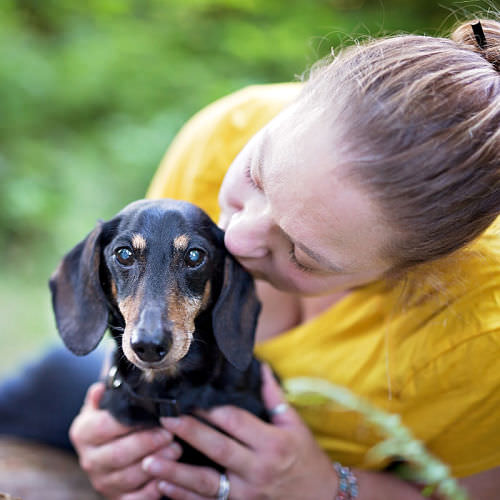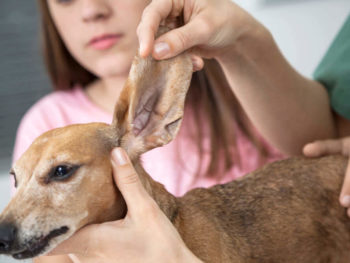I had owned Dachshunds for 12 years, and walked and dog sat many, before I found out how common seizures in Dachshunds are.
Thankfully, an email from a blog reader had made me aware of what Dachshund seizures looked like because one day a dog I was sitting had one.
He was sitting at my feet and dept bumping against my leg a little.
At first, I thought he was licking or scratching himself but it seemed to go on for a couple minutes so I looked down to see what was going on.
What I saw was alarming.
He was stiff and staring off into space. His body was tapping against my leg because he was wobbling back and forth on his feet. He was unresponsive to me.
In his case, even though I knew seizures usually only go on for 10 minutes, and there is often no lasting damage, I rushed him to the vet. The seizure had stopped and he had returned to normal by the time I got there.
It turns out this Dachshund had seizures a few times a year but the owner forgot to tell me (Hint: you should tell your dog sitter these things!).
I’ve seen other people describe their Dachshund having a seizure as “I… found him, apparently lifeless, on the floor with foam around his mouth.”
What is a Dachshund Seizure?
As with humans, seizures in dogs are caused by a misfiring of the brain or an imbalance of brain chemicals.
During this irregular brain activity, a Dachshund will essentially be unconscious but still awake.
When your Dachshund has a seizure, they may seem awake but their brain has shut off. They are essentially unconscious.
Their body will act in strange ways and they will not be able to hear or respond to you. (source)
How Common is it for Dachshunds to Have Seizures?
The Dachshund breed, especially those with the dapple gene, are genetically prone to regular seizures. (source)
If your dog inherited a gene that predisposes him or her to seizures, according to my review of several articles, they will likely have their first one between 6 months and 5 years of age.
Lafora Disease (LD) is also very common in the miniature wirehaired variety of Dachshund. The disease causes short, jerky seizures in addition to other related complications.
It’s also a disease determined by genetics and up to 20% of miniature wire hairs can be affected.
Lafora Disease usually occurs when a Dachshund is older and gets progressively worse.
It’s possible for your dog to have a medically caused seizure at any age.
So, yes, it is more common for Dachshunds to have seizures than many other dog breeds.
What Are the Signs of a Seizure in Dachshunds?
Knowing the signs and symptoms of seizures can help you recognize when your dog is having one.
Knowing how your Dachshund will act while having one will help you mentally prepare to see it happen too (so you don’t panic as much).
Seizure and signs and symptoms include:
- Loss of consciousness (doesn’t always happen)
- Stiffness in all or part of the body
- Falling down or flopping over
- Urination and defecation
- Involuntary movement (such as jerking of part of or the entire body)
- Drooling or “foaming at the mouth”
What Should You Do If You Suspect Your Dachshund is Having a Seizure?
Although it’s very scary and upsetting to us when our Dachshund has a seizure, your dog is not in pain or distress.
Remember above when I said they were unconscious? They don’t know what is going on.
The best thing to do when your dog has a seizure is move all objects away from them, place a pillow or thick blanket under them to avoid self-inflicted injuries, and let nature take it’s course.
During a seizure, move all items away from your Dachshund and don’t restrict their movement.
You should not hold them tightly to restrict their convulsing and don’t try to stick your fingers in their mouth (they might accidentally bite you).
Even though your Dachshund is very unlikely to hear what, specifically, you are saying, speaking to your dog in a soothing voice can sometimes help them relax.
In most cases, seizures in Dachshunds are harmless. They typically resolve themselves within 10-15 minutes with no lasting side effects.
However, they can be super scary the first time and can be an indicator that something is wrong.
It’s a good idea to take him or her to the vet to be examined so the vet can determine what kind of seizure it is and whether there is an underlying medical cause.
It will be helpful to your vet if you take notes about the conditions before and after and the seizure, as well as the duration.
What Causes Seizures in Dachshunds?
A Dachshund can experience a seizure due to genetic predisposition, environmental triggers, or underlying medical conditions… or a combination of more than one of these.
Sometimes your veterinarian may not be able to find a cause.
There can be various reasons that Dachshunds have seizures, and your vet won’t always be able to find the exact cause.
You may be advised to let the seizures run their course but track the details, such as frequency, severity, and symptoms, for a future follow up.
Sometimes a distinct cause can be found.
In those cases, the most common causes are:
- Dehydration
- The ingestion of toxic substances
- Diabetes/low blood sugar
- Brain Tumors
- Heart Disease
If your Dachshund has frequent seizures, but no underlying medical cause can be found, they will most likely be diagnosed with Epilepsy.
Remember that, although seizures can be scary, some Dachshunds are genetically predisposed to them continue to live a normal life.


About the Author: Through her 17 years of owning and caring for Dachshunds, and almost 10 years researching and writing about them, JW has become a respected expert in the Dachshund community. Read more about her here.














 Office Job? Tips for Bringing Your Dachshund to Work
Office Job? Tips for Bringing Your Dachshund to Work


